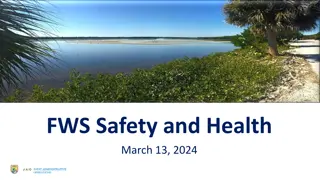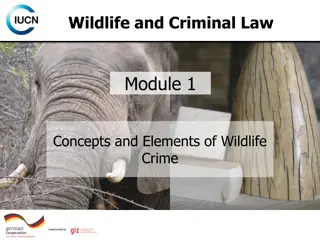Wildlife and Culture Conservation in Tatra Mountains
Tatra National Park in Poland aims to protect the wildlife and culture of the Tatra Mountains for current and future generations. Covering unique alpine terrain, the park boasts diverse flora and strict conservation measures. Discover the significance of Tatra Mountains and the conservation efforts in this pristine natural landscape.
Download Presentation

Please find below an Image/Link to download the presentation.
The content on the website is provided AS IS for your information and personal use only. It may not be sold, licensed, or shared on other websites without obtaining consent from the author.If you encounter any issues during the download, it is possible that the publisher has removed the file from their server.
You are allowed to download the files provided on this website for personal or commercial use, subject to the condition that they are used lawfully. All files are the property of their respective owners.
The content on the website is provided AS IS for your information and personal use only. It may not be sold, licensed, or shared on other websites without obtaining consent from the author.
E N D
Presentation Transcript
VI Edycja YPEF Young People in European Forests - M odzie w Lasach Europy Tatra National Park, Poland Our mission: We try to protect and help to understand the wildlife and culture of Tatra Mountains, making it possible to experience by current and future generations. Our vision: Wildlife is nearly totally virgin, while the precious cultural elements are kept. TPN a model of taking action for other similar organizations. 1 Liceum Og lnokszta c ce im. T. Ko ciuszki w Wieluniu ul. Nadodrza ska 4, 98-300 Wielu Agnieszka Gagatekkl. I Natalia Walaszczyk kl. I Jakub Bokwa kl. I
Tatra Mountains are the only alpine terrain of Poland, therefore they had always been a hard location to get to. Rough terrain and hard conditions made them inhabitable. It allowed nature to take care of Tatra Mountains and covered them from massive transformations. The significance of Tatra Mountains for Polish landscape has its roots not only because of their unique nature, but also because of the mission Polish people had to complete - to take care of soaring crags and alpine animals hidden beyond them - that was the beginning of modern, Polish nature conservancy. Tatra Mountains are the highest mountain chain in Carpathian arc, streching approximately 1300 kilometres through a few Central European countries. Tatra National Park covers the whole fragment of Tatra Mountains in Poland. It is not a big chunk of Tatra Mountains - it covers as much as one fifth of the whole Tatra Mountains only. The surface of Tatra National Park is about 21197 hectares there fore is one of the biggest National Parks in Poland. Approximately 70 per cent of the surface is covered in forests and mountain pine. The remaining 30 per cent are alpine grasses, rocks and waters. The strict protection is granted to almost 11,5 thousand hectares of surface, including whole crag, alpine, sub-alpine, as well as partially the upper and lower montane zones. Strict protection means preservating the processes taking place in natural habitat. Tatra Mountains, elevated over surrounding regions just like any other alipne region, receive much more rain than its neighbouring zones. Annualy there is over 1720 mm of rainwater, while the biggest part happens to be in the summer. In the winter, it rains mostly over the snowy part of the Mountains, which hold the water up to the spring, then releasing it upon the hills in the spring and summer. Some of the water tends to evaporate, some sinks in, most of it falls down upon Tatra Mountains, though. Waters on the surface are covering only as much as approximately 1% of the Tatra Mountains National Park. There are both lakes as permanent water streams.
Flora Some specific plant species occur in specific mountain parts worldwide. It is strictly because of their temperature tolerance. The higher they are, the lower their tolerance is. They prefer specific types of the soil, either. Here's Tatra Mountains altitudinal zonation: lowland level up to 900-1000 metres above sea level lower montane zone - 900-1250m above sea level. Mixed forrests occur there. upper montane zone - 1250-1550m above sea level. It is made of coniferous forests and you can see Swiss pine there. subalpine zone, dwarf pines are located there. It occurs from 1550 to 1850m above sea level. alpine zone - wild grasses, alpine fields, 1850-2300m above sea level. You can see dwarf pines, alpine grasses and tall herbs there. glacier zone, tundra, 2300-2655m above sea level. There are only about 130 species of lichens, 40 within them are also seen above 2600m. In Tatra Mountains there are about 900 species of algae, 1000 of lichens, 1300 of plants. About 40 of them are endemited. Many of the species are endangered.
Nature 2000 To ask "why do we need "Natura 2000"" is like asking "why do we need to preservate the nature?" or "why do we even need a nature". There are people who think they can live without it. Luckily, there aren't many of them. The creation of "Natura 2000" net is the answer against rapidly increasing processes which are destroying our plantet, which have began a few decades ago. Biodiversity indicated in species amount is also decreasing. According to European Environment Agency, in the recent years as much as 64 european endemites gone extinct in the nature, and 38% of the birds and 45% of the butterflies are seriously endangered to become extinct. Even though Tatra Mountains are only a small of broad Carpathians mountain range, they are the highest and the most precious mountain massive between the Alps and Caucasus, with its characteristic alpine landscape and typical altitudinal zonation. It's a region of exceeding significance for biodiversity's preservation.17 bird species living there were included in the first Bird Directive of the UE. Also, 31 animal habitats from Tatra Mountains were included in UE's Habitat Directive, just like 7 species of plants from the second Habitat Directive. Diversed flora ( about 1000 species of vascular plants) and fauna are also including many endangered and rare Polish species, guarded by law. Many of them besides having their only habitats in Tatra Mountains are precious in the whole Europe. Beyond the plant there are: Cochlearia tatrae Borbas, Pulsatilla slavica G. Reuss, and beyond animals: Rupicapra tatrica, Marmota Latirostris, the most known species from Tatra Mountains. Moreover, in the time of mating, it's the only region of Poland inhabited by Prunella collaris, Tichodroma muraria and Eudromias morinellus.
"Sea Eye" Sea Eye is one of the most eagerly visited places near Zakopane. It's the biggest Tatra lake located in Dolina Rybiego Potoku (literally: The Valley of Fish Stream), about 25km from Zakopane. The lake's nature is postglacial and it's got about 35 hectares of surface, the deepest spot in the whole lake is 51m. The water is transparent, one can look into the lake as deeply as into 12m. In the past, Morskie Oko was called "Rybie Jezioro" ("Fish Lake") due to its natural stock of fish, which are uncommon in Tatra lakes and ponds. In the clear depths of the water, one can easily notice trout - so called "famine" trout - that live in the lake. In the winter tourists can walk on its surface, the only condition is that it has to be frozen enough.























